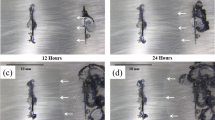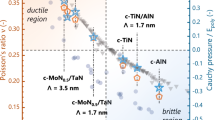Abstract
THE importance of surface conditions in the fatigue of metals and alloys has led to an investigation in this Laboratory into the effect of abrasion on the hardness and microstructure of surface and subsurface layers.
This is a preview of subscription content, access via your institution
Access options
Subscribe to this journal
Receive 51 print issues and online access
$199.00 per year
only $3.90 per issue
Buy this article
- Purchase on Springer Link
- Instant access to full article PDF
Prices may be subject to local taxes which are calculated during checkout
Similar content being viewed by others
References
Nelson, H. R., Special Summer Conference on "Friction and Surface Finish", Massachusetts Institute of Technology, June 1940.
Moore, A. J. W., C.S.I.R. Lubrication and Friction Report No. 44 (unpublished).
Wulff, John, Trans. Amer. Inst. Mech. Eng., Iron and Steel Division, 295 (1941).
Benard, J., Lacombe, S. P., and Chaudron, G., "Journées des Etats de Surface" (Paris, October 1945).
Author information
Authors and Affiliations
Rights and permissions
About this article
Cite this article
DANCE, J., NORRIS, D. Structure of Abraded Surfaces. Nature 162, 71–72 (1948). https://doi.org/10.1038/162071a0
Issue Date:
DOI: https://doi.org/10.1038/162071a0
This article is cited by
-
Positron annihilation study of dislocations produced by polishing in the surface of iron single crystals: Part I. Density profile and removal by annealing
Metallurgical Transactions A (1990)
-
Dislocation density profile of mechanically polished iron single crystals determined by positron annihilation
Journal of Materials Science Letters (1986)
-
Plastic deformation below worn surfaces
Metallurgical Transactions A (1976)
-
Plastic deformation below worn surfaces
Metallurgical Transactions A (1976)
Comments
By submitting a comment you agree to abide by our Terms and Community Guidelines. If you find something abusive or that does not comply with our terms or guidelines please flag it as inappropriate.



